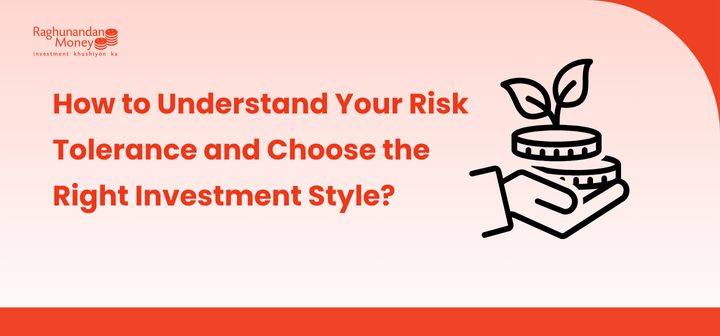How to Understand Your Risk Tolerance and Choose the Right Investment Style?
Post Date : April 29, 2025

Disclaimer: Investments in the securities market are subject to market risks. This content is for educational purposes only and does not constitute financial advice.
Achieving success in stock market investing involves more than just selecting the right tools or timing the market. A deeper level of self-awareness—particularly around your risk tolerance and investment style—forms the foundation of a sound, personalized strategy. Ignoring these elements can result in poor decisions, emotional investing, and missed long-term goals.
This blog explores what risk tolerance means, how to assess it, and how different investment styles align with individual preferences and financial circumstances.
What Is Risk Tolerance?
Risk tolerance refers to your ability and willingness to endure investment losses in the pursuit of potentially higher returns. It is influenced by a variety of factors, including:
- Age and stage of life
- Financial stability
- Investment goals
- Time horizon
- Personal comfort with risk
It includes both objective capacity (your financial strength to withstand losses) and subjective willingness (your emotional readiness to take risks).
Example: A 28-year-old software engineer with a steady income and no dependents may tolerate a 30% dip in their portfolio without major lifestyle changes. However, a retiree dependent on investment income may have far less capacity for such losses.
Investment Styles: A Spectrum of Risk and Return
Choosing the right investment style is crucial for aligning your strategy with your risk tolerance. Below are the most common approaches:
1. Conservative Investing
Focused on capital preservation and stability. Typically includes:
- Government securities
- High-quality corporate bonds
- Blue-chip stocks with consistent performance
Suitable for investors with low risk tolerance and short-term goals.
2. Moderate Investing
Balances capital appreciation with risk control. Usually involves:
- A diversified mix of stocks and bonds
- Potential allocation to mutual funds or index funds
- Occasional exposure to alternative assets
Ideal for medium-term goals or moderate risk tolerance.
3. Aggressive Investing
Targets high returns and accepts increased volatility. Common elements include:
- High-growth stocks
- Sector-specific or emerging market investments
- Minimal allocation to low-risk instruments
Best suited for long-term investors with high risk tolerance.
4. Value Investing
Involves identifying undervalued companies through in-depth analysis. Characteristics include:
- Long-term investment horizon
- Strong emphasis on fundamentals
- Patience to wait for market corrections
Favoured by investors who seek stability with potential upside.
5. Growth Investing
Focuses on companies with high growth potential, often in innovative sectors. Typical traits:
- Emphasis on earnings growth
- Willingness to accept higher price volatility
- Limited or no dividends
Attractive to investors comfortable with short-term fluctuations for long-term gains.
6. Income Investing
Aims to generate regular income through:
- Dividend-paying stocks
- Bonds and fixed-income securities
- Real Estate Investment Trusts (REITs)
Preferred by retirees or those looking for predictable cash flow.
7. Index Investing
A passive strategy that replicates the performance of a market index using:
- Index mutual funds
- Exchange-Traded Funds (ETFs)
Appeals to investors who prefer simplicity, broad diversification, and lower fees.
Why Risk Tolerance Matters
Risk tolerance should not be treated as an afterthought. It directly affects every aspect of investing:
- Emotional Control: Staying within your comfort zone reduces panic-driven decisions during market volatility.
- Consistency: Aligning your portfolio with your risk tolerance makes it easier to stick with your plan over the long term.
- Suitability: Advisors are ethically obligated to match investments with your risk profile. Misalignment can lead to unsuitable, high-risk choices.
- Portfolio Design: Asset allocation is based primarily on your risk appetite, determining how much you invest in equities, debt, or alternative assets.
Failing to understand or respect your risk tolerance can negatively impact your financial health and decision-making.
How to Assess Your Risk Tolerance
Assessing your risk tolerance is an essential starting point before building an investment strategy. Consider the following approaches:
- Use Risk Profiling Tools: Financial platforms and advisors often provide questionnaires to help identify your risk category.
- Evaluate Your Time Horizon: The longer you have until your goal, the more risk you can generally afford to take.
- Analyze Your Finances: Consider income stability, debt levels, emergency funds, and the number of dependents.
- Reflect on Past Behavior: How have you reacted to market volatility in the past? Were you calm or reactive?
- Simulate Scenarios: Imagine a 20–30% market drop. Would you stay invested, invest more, or sell? Your answer offers insight into your emotional threshold for risk.
Risk tolerance is dynamic. As life circumstances and financial goals evolve, so too should your assessment and strategy.
Conclusion
Understanding your risk tolerance and aligning it with an appropriate investment style is key to long-term investing success. It empowers you to make decisions that are not only financially sound but also emotionally sustainable. The best investment strategy is one that reflects your unique situation—not just market trends.
Whether you’re a cautious investor seeking stability or a risk-taker chasing growth, taking the time to assess and align your investment style can make all the difference.
Need Help?
Contact RMoney at 0562-4266600 / 0562-7188900 or email us at askus@rmoneyindia.com

Stock Trading Now trade in ₹9 Per Order or ₹ 999 Per Month Plans.
Future & Options Access F&O contracts with advanced tools for hedging and speculation.
Currency Trading Trade in major currency pairs and manage forex exposure efficiently.
Commodity Trading Diversify Trading with MCX & NCDEX by Trading in Gold, Silver, Base Metals, Energy, and Agri Products.
Margin Trading Funding Boost your buying power with upto 5X, Buy now Pay Later
Algo Trading Back test, Paper Trade your logic & Automate your strategies with low-latency APIs.
Trading View Leverage Trading View charts and indicators integrated into your trading platform.
Advanced Options Trading Execute multi-leg option strategies with precision and insights.
Stock Lending & Borrowing Earn passive income by lending stocks securely through SLB.
Foreign Portfolio Investment Enable NRIs and FPIs to invest in Indian markets with ease and compliance.
IPO Invest in upcoming IPOs online with real-time tracking and instant allotment updates.
Direct Mutual Funds 0% Commissions by investing in more than +3500 Direct Mutual Fund Scheme.
Corporate FDRs Earn fixed returns with low-risk investments in high-rated corporate fixed deposits.
Stocks SIPs Build long-term wealth with systematic investment plans in top-performing stocks.
Bonds & NCDs Access secure, fixed-income investments through government and corporate bond offerings.
Depository Services Safely hold and manage your securities with seamless Demat and DP services with CDSL.
Journey Tracing our growth and milestones over time.
Mission & Vision Guided by purpose, driven by long-term vision.
Why RMoney Platform Smart, reliable platform for all investors' needs.
Management Experienced leadership driving strategic financial excellence.
Credentials Certified expertise with trusted industry recognition.
Press Release Latest company news, updates, and announcements.
Testimonials Real client stories sharing their success journeys.
7 Reasons to Invest Top benefits that make investing with us smart.
SEBI Registered Research Trusted insights backed by SEBI-compliant research.
Our Technology Advanced tools enabling efficient online trading.
Calculators Access a suite of smart tools to plan trades, margins, and returns effectively.
Margin Calculator Instantly check margin requirements for intraday and delivery trades.
MTF Calculator Calculate MTF funding cost upfront to ensure full transparency before placing a trade.
Brokerage Calculator Know your exact brokerage charges before placing any trade.
Market Place Explore curated investment products and trading tools in one convenient hub.
RMoney Gyan Enhance your market knowledge with expert blogs, videos, and tutorials.
Performance Tracker Track our research performance with full transparency using our performance tracker.
Feedback Share your suggestions or concerns to help us improve your experience.
Downloads Access important forms, software, and documents in one place.
Locate Us Find the nearest RMoney branch or service center quickly.
Escalation Matrix Resolve issues faster with our structured support escalation process.
Back Office Log in to view trade reports, ledger, and portfolio statements anytime.
Account Modification Update personal or bank details linked to your trading account.
Fund Transfer Transfer funds instantly online with quick limit updation to your trading account.
Bank Details View our registered bank account details for seamless transactions by NEFT, RTGS or IMPS.
How to Apply IPO Step-by-step guide to apply for IPOs using your trading account.
RMoney Quick Mobile App Trade on-the-go with our all-in-one mobile trading app.
RMoney Quick login Quickly access your trading account through the RMoney Quick web-based trading.
RMoney Rocket Web Version Experience powerful web-based trading with advanced tools for algo traders.
RMoney Rocket Mobile Version Trade anytime, anywhere with our feature-rich mobile trading platform.












